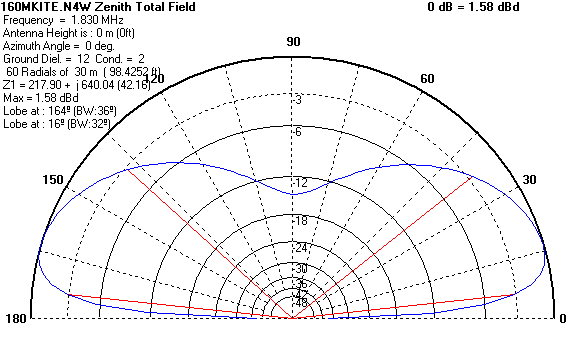The balloon kite arrangement I use involves the Helikite
Sky Hook or the Lightweight Helikite to support the antenna wire . The Sky Hook is larger than the 'bird scaring' range of
Light Weight Helikites, and will fly in wet weather. The two types of
Helikite that I use are highlighted.
Helium Capacity Lift No
wind Lift in
Wind
Max
Wind Max
Altitude Vigilante Helikite
0.15 m3
0.03 Kg
0.15 Kg
25 mph 1,000 ft
Lightweight
Helikite
0.15 m3
0.06 Kg
0.18 Kg
25 mph 1,300 ft
Skyhook Helikite 1.0 m3 0.4 Kg 1.5 Kg 28 mph
2,000 ft
Skyhook Helikite
1.3 m3
0.7 Kg
2.5 Kg
31 mph 2,500 ft
The Helikite Sky Hook will just about lift the quarter wave (40 metres) of number 14 flexiweave wire without wind, but any breeze at all takes it right up with the additional generated lift. The designed angle of flight of the Helikites is 45 degrees or a bit more, making it not quite a true vertical but certainly a lot more vertical than an inverted 'L'. Sometimes
instead of the Sky Hook I use two Light Weight Helikites if the wind is lighter, as it two in a 'train' generates additional lift.To deploy the balloon/kite antenna, the 12 metre SCAM12 mast is nested at 2 metres, a 4 metre fibreglass stub is inserted into the top at the 40mm spigot. A 150 kg. breaking strain fishing swivel is attached to the top of the stub to keep twisting to a minimum. All attachments are made with 200 kg. breaking strain Kevlar line. On each side of the swivel is about 10 cm. of Kevlar line.
The antenna wire to the Sky Hook is run from a small
plastic insulator at the swivel to the Helikite, with the last two metres being Kevlar attached to a small high strength porcelain insulator. Another swivel at the Helikite attachment point takes care of the last of the twisting. The final bit of additional Kevlar keeps any arc away from the attachment point and saves chasing the Helikite across the country as it flies to 1 to 2 thousand feet and drifts rapidly away. (My insurance has paid for two escapees that took off)The Sky Hook is then released, the 40 metres of flexiweave antenna wire played out, and then the pump up mast is put into the full up position, SLOWLY, to avoid strain on the kite antenna wire.
If you don't have a collapsible mast, just a two or three metre pole, well anchored, can be used, and more kite or balloon line deployed to make up the length required for the 1/4 to 3/8 wave antenna. Even a dog lead corkscrew available from pet shops will hold it down in most cases and then the antenna is all wire. As they say, your mileage will vary!
The soil around where I live is very sandy, but I am not far from the North Sea. The antennas for Top Band work well. Here is a plot of the Helikite supported 'Protracted L' antenna, plotted with a ground loss of about 10 ohms. That is my estimated ground loss based on measurements of antennas of a know feed impedance over perfect ground, and subtracting the theoretical value from the bridged feed point value. I have about 60 radials from 45 to 120 feet in length. I think this plot
of the 'Protracted L' is fairly accurate.|
This is the 'Protracted L' in the air
|


